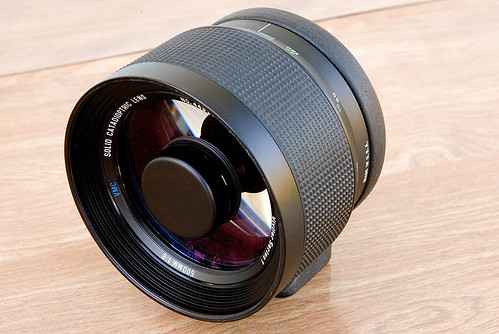Difference between revisions of "Mirror lens"
(adding another CW photo; removing empty "references" subhead for now) |
m (+Glossary banner; 2 cats; heading levels) |
||
| Line 1: | Line 1: | ||
| + | {{glossary}} | ||
{|class=floatright | {|class=floatright | ||
| | | | ||
| Line 20: | Line 21: | ||
}} | }} | ||
|} | |} | ||
| + | |||
Mirror lenses, or catadioptric lenses, combine curved mirrors (catoptrics) with glass lens elements (dioptrics). Used only for long [[Lens#Long-focus (Telephoto)|telephoto lenses]], the design provides a much shorter, lighter, and less expensive lens than a comparable conventional telephoto lens. | Mirror lenses, or catadioptric lenses, combine curved mirrors (catoptrics) with glass lens elements (dioptrics). Used only for long [[Lens#Long-focus (Telephoto)|telephoto lenses]], the design provides a much shorter, lighter, and less expensive lens than a comparable conventional telephoto lens. | ||
In spite of some advantages, optical shortcomings mean that they have never been very popular for general photography | In spite of some advantages, optical shortcomings mean that they have never been very popular for general photography | ||
| − | =Construction= | + | ==Construction== |
The short broad shape of a catadioptric lens is very distinctive, as is the back of the secondary mirror visible at the front of the lens. Light is reflected by the primary mirror at the rear of the lens onto the much smaller secondary mirror and from it through the conventional optics and onto the film or sensor. This double folding of the light path makes the lens very short for its focal length. The large primary mirror provides most of the magnification. | The short broad shape of a catadioptric lens is very distinctive, as is the back of the secondary mirror visible at the front of the lens. Light is reflected by the primary mirror at the rear of the lens onto the much smaller secondary mirror and from it through the conventional optics and onto the film or sensor. This double folding of the light path makes the lens very short for its focal length. The large primary mirror provides most of the magnification. | ||
| − | ==Advantages== | + | ====Advantages==== |
Relatively small size and light weight are the main advantages for a photographer. The catadioptric design provides a very high degree of optical correction, making such lenses popular for astronomy. | Relatively small size and light weight are the main advantages for a photographer. The catadioptric design provides a very high degree of optical correction, making such lenses popular for astronomy. | ||
| − | ==Disadvantages== | + | ====Disadvantages==== |
The optical design precludes fitting a diaphram and such lenses are always fixed aperture. Light adjustment can only be by use of neutral density filters. | The optical design precludes fitting a diaphram and such lenses are always fixed aperture. Light adjustment can only be by use of neutral density filters. | ||
Catadioptric lenses have relatively low contrast, quite acceptable for astronomy but a severe drawback for general photography. In addition, out of focus highlights will appear as doughnut shapes, distinctive and not always pleasing. | Catadioptric lenses have relatively low contrast, quite acceptable for astronomy but a severe drawback for general photography. In addition, out of focus highlights will appear as doughnut shapes, distinctive and not always pleasing. | ||
| + | |||
| + | [[Category:Glossary]] [[Category:Lenses]] | ||
Revision as of 05:20, 7 February 2012
| ||
|
Mirror lenses, or catadioptric lenses, combine curved mirrors (catoptrics) with glass lens elements (dioptrics). Used only for long telephoto lenses, the design provides a much shorter, lighter, and less expensive lens than a comparable conventional telephoto lens.
In spite of some advantages, optical shortcomings mean that they have never been very popular for general photography
Construction
The short broad shape of a catadioptric lens is very distinctive, as is the back of the secondary mirror visible at the front of the lens. Light is reflected by the primary mirror at the rear of the lens onto the much smaller secondary mirror and from it through the conventional optics and onto the film or sensor. This double folding of the light path makes the lens very short for its focal length. The large primary mirror provides most of the magnification.
Advantages
Relatively small size and light weight are the main advantages for a photographer. The catadioptric design provides a very high degree of optical correction, making such lenses popular for astronomy.
Disadvantages
The optical design precludes fitting a diaphram and such lenses are always fixed aperture. Light adjustment can only be by use of neutral density filters.
Catadioptric lenses have relatively low contrast, quite acceptable for astronomy but a severe drawback for general photography. In addition, out of focus highlights will appear as doughnut shapes, distinctive and not always pleasing.

